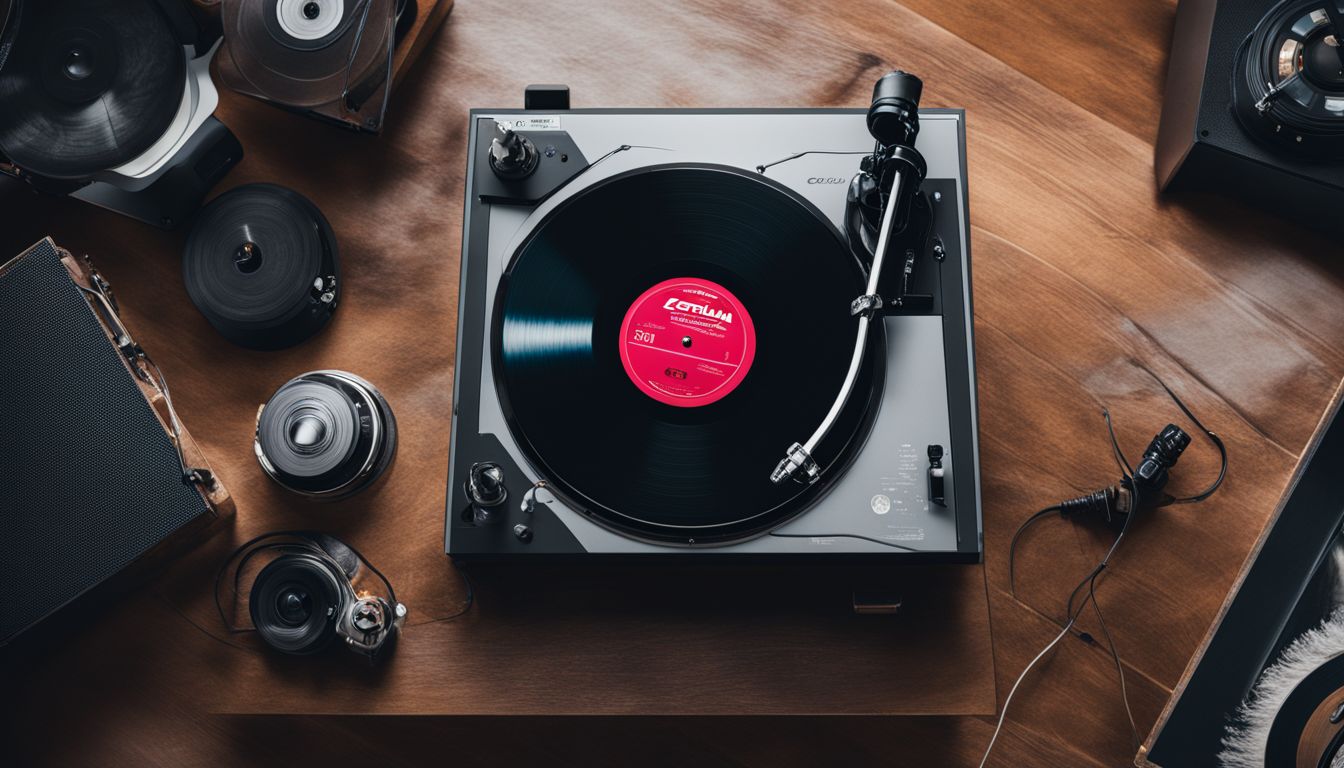Many vinyl enthusiasts know the frustration of a skipping stylus and distorted sound. Anti-skate is an essential feature on turntables that addresses this very issue, ensuring that your music plays smoothly.
This article will illuminate anti-skating’s role and show you how to perfect your listening experience by using it effectively. Discover the secret to flawless vinyl playback—keep reading!
Key Takeaways
- Anti-skating is a feature on turntables that applies a counterforce to prevent the tonearm from being pulled towards the center of the record, which can cause sound distortion and excessive wear on vinyl.
- Correctly setting the anti-skate force ensures clear audio playback, protects your records from scratches, and extends the life of your stylus by preventing uneven pressure on either side of a record groove.
- The anti-skate mechanism works in tandem with the tracking force; both need to be adjusted properly for optimal sound quality and to maintain the health of your vinyl collection.
- Adjusting anti-skate involves locating the control on your turntable, setting it according to the recommended tracking force for your cartridge, and fine-tuning while listening for any distortion or imbalances in sound.
- Regularly check and adjust anti-skating settings as needed since environmental factors like temperature changes can affect its performance over time. Trust what you hear and make adjustments until you achieve stable playback without inner groove distortion.
Understanding Anti-Skating on a Turntable
Anti-skating on a turntable plays a pivotal role in the longevity of vinyl records and the quality of sound they produce. Imagine your record playing, and there’s an invisible force pulling the tonearm towards the center of the disc.
This is what audiophiles call skating force, which, if left unchecked, causes uneven wear on your precious records and disrupts channel balance. It can lead to one side of a stereo recording playing louder than the other or even result in unwanted noise.
Here’s where anti-skating comes into play; it applies a counterforce that balances out this inward pull, ensuring that the styli remains centered in the record groove as it spins.
This mechanism is critical for achieving clear audio without distortion from excess pressure on either side of a stereo groove. By preventing sideways stress on the needle tip, a well-set anti-skate adjusts for various tracking forces and ensures that each musical note is captured as intended.
The House of Marley Stir It Up Wireless Turntable shines here with its user-friendly anti-skate feature, guaranteeing optimal performance alongside its modular Audio-Technica phono cartridge—two indispensable tools for any music enthusiast seeking pristine playback while protecting their vinyl collection from unnecessary scratches.
How Does Anti-Skating Work?
Moving from the concept to its practical application, we explore how anti-skating devices maintain harmony on your record player. The mechanism works by exerting a small force to counteract the tonearm’s inclination to skate towards the center, which is a result of friction between the stylus and vinyl as well as angular velocity during playback.
Think of it like a figure skater using their arms for balance; in this case, however, it’s about balancing sound quality against potential damage.
Inside most phonograph turntables with this feature, you’ll find either a weight- or spring-based mechanism that produces an opposing lateral force. Adjustable controls—whether it be a dial or sliding weight—are used to meticulously calibrate this force, and they are situated near where the tonearm pivots.
Ensuring this delicate equilibrium prevents scratching and excessive wear while promoting an even distribution of tracking force across the groove landscape of your records, leading to crisp audio without distortion.
The Relationship Between Anti-Skating and Tracking Forces
The anti-skating force balances the tracking force exerted by the needle on a record, playing a crucial role in ensuring that the stylus stays centered in the groove and providing clear and undistorted sound as it picks up every detail inscribed into the vinyl. The delicate equilibrium ensures that the stylus stays centered in the groove, picking up every detail inscribed into the vinyl and providing clear and undistorted sound.
Without properly set anti-skating, your turntable’s needle might push too hard on one side of the groove, leading to uneven wear, poor audio quality, and diminishing the lifespan of both your records and stylus.
Setting this balance is essential for audiophiles who demand high-fidelity playback from their record collections. A correctly adjusted anti-skating mechanism aligns with the chosen tracking force to avoid unnecessary pressure that can deform vinyl grooves over time.
Not only does this preserve your records but it also maintains the consistent performance of your phono cartridge, delivering crisp music free from unwanted noise or skips. Every spin of a record is as perfect as its creators intended by understanding how these two forces interact.
The Benefits of Anti-Skating
Knowing how to properly use antiskating on your turntable is crucial for a top-notch listening experience. Anti-skating devices enhance the longevity and performance of your vinyl records.
- Preserving Your Vinyl: Antiskating helps maintain the quality of your records. It exerts an equal but opposite force to counteract the inward pull on the tonearm, ensuring that it stays in the center of the groove.
- Protecting the Needle: With the correct antiskating settings, you reduce needle wear. This can save you money by extending the life of your stylus and maintaining accurate sound reproduction.
- Sound Quality Enhancement: Setting up anti-skate properly means clearer sound. It reduces distortion that might occur when the stylus drags unevenly across a record’s surface.
- Balance and Stability: Proper antiskating ensures the cartridge stays balanced. This prevents one channel from sounding louder than the other, which is key to high-fidelity audio.
- Avoiding Scratches: Anti-skating applies just enough force to keep the needle from scratching your records. It makes sure that even during dynamic passages, where groove modulation is higher, there’s minimal risk of damage.
How to Set an Anti-Skating Device
Setting up the anti-skating feature on your turntable is critical for getting the best sound and protecting your vinyl records. Here are the steps to properly adjust the anti-skating force for optimal playback:
- Locate the anti-skating control on your turntable, which could be a dial, knob, or a small weight on a string near the tonearm base.
- Set your tracking force according to the cartridge manufacturer’s recommendation. Adjust the tracking force by manipulating the counterweight located at the back of the tonearm.
- Set the anti-skating mechanism to match this tracking force initially as a starting point.
- Play a record with a blank or lead-out groove and listen for any signs of distortion or skipping to assess if more adjustment is needed.
- Make incremental adjustments to fine-tune. Turn up the anti-skating slightly if you notice sound distortion in one channel or if the tonearm seems to be pulling towards the center of the record.
- Conduct a balance test: Use a specialized anti-skate test record with multiple tracks designed to check skating force at different tracking forces.
- Observe how well the stylus stays centered in these test grooves; adjust it until it remains stable without being pulled inward or pushed outward.
- Recheck your settings after playing several records, as changes in temperature and humidity can affect turntable performance over time.
- Trust your ears: Ultimately, rely on what sounds best through careful listening, since each record and turntable setup may have unique characteristics requiring slight variations in settings.
Conclusion
Understanding anti-skate on a turntable isn’t just about getting your music to sound right; it’s crucial for the life of your vinyl collection. With this feature properly dialed in, you can ensure that every note plays as intended without damaging your precious records.
As you savor the rich, full sounds of your favorite tracks, remember that the correct anti-skate adjustment is an unsung hero in achieving audio bliss. Let your records spin with confidence, knowing they’re getting the gentle touch they deserve from a well-calibrated turntable.
Embrace these insights and make them part of your vinyl experience; after all, great sound starts with proper care.
FAQs
What exactly is turntable anti-skating?
Turntable anti-skating is a feature on record players that balances the tonearm, preventing it from sliding toward the center of the record, which ensures accurate playback and protects your records.
Why should I care about anti-skate on my turntable?
Anti-skate matters because it keeps the stylus from wearing out one side of the groove in your records, allowing them to last longer and sound better every time you play them.
Can adjusting the anti-skate improve my listening experience?
Absolutely! Setting up anti-skate correctly gives you clearer sound by making sure the stylus tracks each groove with precision instead of skating across and missing details in the music.
Is setting up anti-skate something I can do myself?
Yes, you can set up Anti-Skate yourself if you follow your turntable’s manual instructions carefully; this will ensure optimal performance for both new models like Rega Planar and classic direct-drive turntables.


